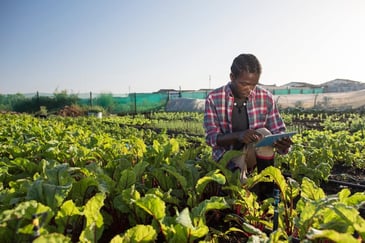The Effects of Environmental Racism

When talking about the environment, it’s easy for people to jump to the big “E” Environment—which is more like the idea of the environment—nature, trees, national parks, large expanses of green space that must be protected. But the environment is also the space directly around you. It’s your community; you can be in the middle of a city, a suburban strip mall, or a rural area, but that’s still the environment. And that distinction is important.
Every person depends on their environment for safety and sustenance. Clear air, clean water, access to green space, healthy food, and environmental stability affect the health and security of entire communities. When these aspects are compromised, everyone feels the harmful effects. Environmental injustice occurs when poor or marginalized communities experience disproportionate harmful effects from hazardous waste, resource extraction, pollution, and other ecological changes.
These kinds of injustices commonly affect minority populations. Deep-rooted cultural biases have led to environmental racism towards certain people groups. It’s up to us to analyze the effects of environmental racism and find a way to move forward.
What is environmental racism?
Environmental racism was first termed by Rev. Dr. Benjamin F. Chavis Jr. during a North Carolina protest in 1982. The residents of Warren County (home to the highest population of Black residents in the entire state) were protesting the imminent landfill pollution near their homes. Dr. Chavis was among nearly 500 people who were arrested. He coined the term “environmental racism” from a jail cell, referring to the intentional placement of waste facilities and pollution in areas populated by minority ethnic communities.
Environmental racism is a type of systemic discrimination wherein communities of color bear a heavier burden of environmental risks compared to more affluent and primarily white communities. It’s made possible (and continually reinforced) by structural inequalities, discriminatory policies, and socioeconomic disparities.
This concept acknowledges that race, along with socioeconomic status, plays a significant role in determining an individual or community’s vulnerability to environmental harm.
Environmental racism statistics
- Minority communities are significantly more likely to be exposed to health risks due to increased pollution and other environmental justice issues
- Black Americans are exposed to 56% more pollution than they produce
- Latinx Americans are exposed to 63% more pollution than they produce
- Black Americans are 75% more likely than white populations to live in “fence-line” communities (areas near commercial facilities that produce noise, odor, traffic, or emissions)
The environmental injustice in Warren County was just one of many examples of environmental racism in the U.S. The water crisis in Flint, Michigan, occurred in an area home to a majority Black population, with one-third of residents living below the poverty line.
Louisiana’s “Cancer Alley,” an 85-mile stretch between New Orleans and Baton Rouge with a majority black population, contains about a quarter of the nation’s petrochemical production, among other industries adding to the area's toxic load. The residents have been pushing back against the unjust environmental burden that’s been leading to health problems in minority communities for generations.
What are the effects of environmental racism?
Environmental racism has consequences—on public health, on the economy, and on the long-term development of communities.
Environmental health disparities
Communities affected by environmental racism often experience higher rates of chronic illnesses, including respiratory diseases, cardiovascular issues, and certain types of cancer. These can be attributed to the disproportionate exposure to environmental hazards and pollutants.
Systemic racism has caused environmental injustice by supporting policies that discriminate against minority communities. This deep-rooted environmental racism disproportionately affects generations of families, changing health outcomes and disrupting daily life. For example, approximately 13.4% of Black children suffer from asthma as compared to only 7.3% of white children. But do outcomes like these really trace back to environmental issues?
Yes, and here are some examples of how it happens.
North Carolina became home to concentrated animal feeding operations (CAFOs) during the industrial pork production explosion of the late 1980s and early ‘90s. These mega facilities are primarily located in predominantly Black communities and low-income areas. CAFOs in the state produce 10 billion gallons of waste a year, which results in water and air pollution — not to mention a horrific odor.
Waste is typically stored in massive, open-air pits or mounds. In an attempt to “recycle” the nutrients in the waste itself, it is then sprayed over cropland as fertilizer. But this waste regularly escapes the confines of the farm and makes its way into the surrounding environment. Residents say they can actually feel the spray (the fecal waste) raining down on them. Poultry waste stored in giant piles can wash away in the rain or blow away in the wind. Pig waste can leak or overflow, causing the death of fish in nearby waterways and groundwater contamination that taints well water, which is the only water many rural residents have access to.

Hog waste pits become submerged during Hurricane Floyd in 1999; photo courtesy of Rick Dove/Waterkeeper Alliance; How Black North Carolinians Pay the Price for the World’s Cheapest Bacon, Vox
Children who live and attend school near CAFOs in NC experience higher levels of asthma and wheezing compared to those who don’t. Residents within one and a half miles describe elevated blood pressure, eye, nose, and throat irritation, difficulty breathing, nausea, and chest tightness. All of this gets worse as the odor does. One study illustrated that North Carolina communities located near hog CAFOs had higher all-cause and infant mortality, mortality due to anemia, kidney disease, tuberculosis, septicemia, and higher hospital admissions/ED visits of infants with low birth weight.
Flint, Michigan and its ongoing water crisis is an example of what happens when the people in charge make decisions without adequate testing or treatment — and when they fail to listen to the communities directly impacted. In 2011, a cash-strapped Flint fell under state control, and in 2014, it switched its drinking water supply from Detroit’s system to the Flint River as a cost-saving measure. The river water was highly corrosive, and officials failed to treat it properly.
For 18 months, residents complained of foul-smelling, discolored, off-tasting water that caused skin rashes, hair loss, and itchy skin. These issues were chronically overlooked, and officials maintained that the water was safe.
Surprise, the water wasn’t safe. Researchers at Virginia Tech found that citywide lead levels had spiked, with nearly 17 percent of samples registering above the federal action level of 15 parts per billion (ppb) — meaning corrective action must be taken. More than 40 percent measured above five ppb of lead — a serious problem. Just a year later, a Flint pediatrician found the incidence of elevated blood-lead levels in children had nearly doubled since 2014—and nearly tripled in certain neighborhoods. In addition to lead, the switch coincided with an outbreak of Legionnaires’ disease that killed 12 and sickened nearly 100 people.
Environmental racism affects thousands of people across the country, impacting the quality of life and adding to the burden of low-income communities. Though waste management has improved by leaps and bounds in recent decades, there’s a long way to go in creating a safer future for minority communities.

In the Shadows of Industry: LA County’s Port Communities, Pablo Unzueta
Creating a Safer Future with Environmental Justice Principles
Taking action against environmental racism starts with the right framework to make change. The 17 principles of environmental justice were drafted at the National People of Color Environmental Leadership Summit in 1991, after nearly 300 Black, Native, Latino, Pacific Islander, Asian American, and other minority activists gathered for the first time to discuss the environmental injustices they were facing.
Overall, the principles of environmental justice focus on four major ways that we can disrupt systemic environmental racism:
- Increasing ecological protection and safety within disadvantaged communities
- Expanding cultural awareness and addressing potential language barriers
- Promoting environmental education
- Providing additional opportunities for everyone to participate in the decision-making process, regardless of race or socioeconomic status
These principles support the human rights of disadvantaged populations across the nation, making tangible moves toward justice and the removal of systemic barriers.
Addressing the Realities of Environmental Justice at Bard
With the reality of environmental racism and the issues caused by poor waste management and discriminatory policies, now more than ever, we need to stand for environmental justice. No role is too small in the fight against environmental injustice.
At Bard, we empower environmental justice champions through transformative degree programs where sustainability is baked in, not bolted on. We educate leaders in social justice, emphasizing an actively anti-racist curriculum that centralizes social justice within environmental contexts and focuses on racial, social, and gender equity.
Bard’s Graduate Programs in Sustainability are making waves in environmental policy, sustainable business, and environmental education. We integrate social and environmental justice in business, education, and policy to shape the environmental leaders of tomorrow. Whether you are looking for environmental justice jobs or are just embarking on your environmental justice journey, we have a program for you.
If you’re interested in joining the movement and becoming an agent of change, download our guide on the state of environmental justice.




